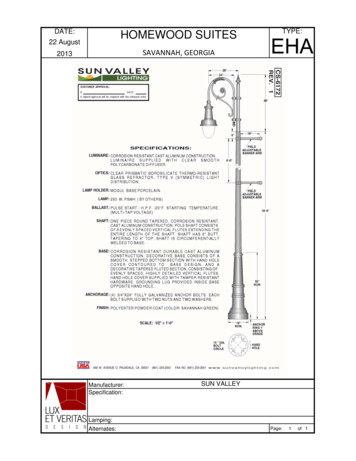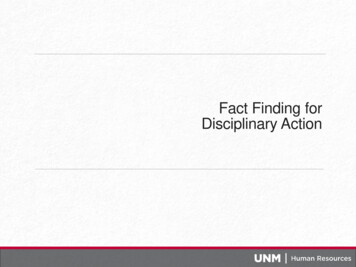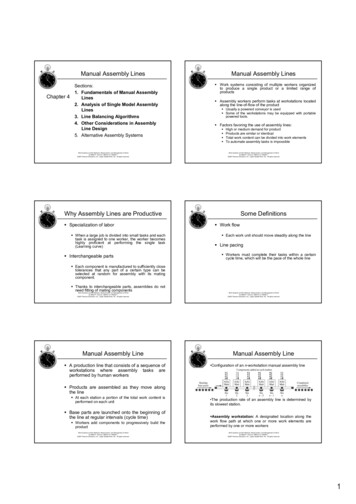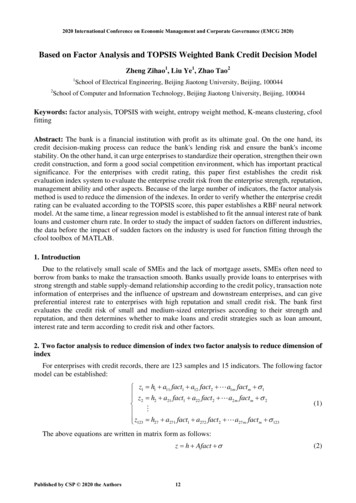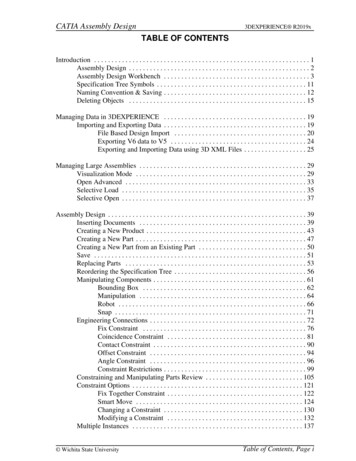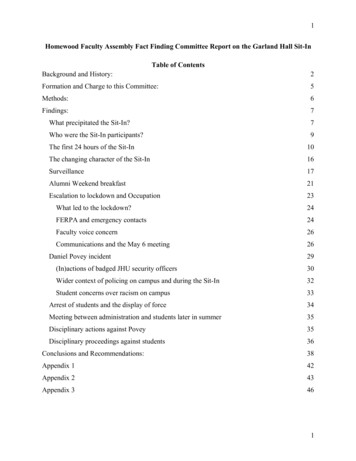
Transcription
1Homewood Faculty Assembly Fact Finding Committee Report on the Garland Hall Sit-InTable of ContentsBackground and History:2Formation and Charge to this Committee:5Methods:6Findings:7What precipitated the Sit-In?7Who were the Sit-In participants?9The first 24 hours of the Sit-In10The changing character of the Sit-In16Surveillance17Alumni Weekend breakfast21Escalation to lockdown and Occupation23What led to the lockdown?24FERPA and emergency contacts24Faculty voice concern26Communications and the May 6 meeting26Daniel Povey incident29(In)actions of badged JHU security officers30Wider context of policing on campus and during the Sit-In32Student concerns over racism on campus33Arrest of students and the display of force34Meeting between administration and students later in summer35Disciplinary actions against Povey35Disciplinary proceedings against students36Conclusions and Recommendations:38Appendix 142Appendix 243Appendix 3461
2Background and History:On Friday May 10, 2019, the Homewood Faculty Assembly of the Johns Hopkins KriegerSchool of Arts and Sciences and Whiting School of Engineering passed a motion to establish aFact Finding Faculty Committee (FFC) to inquire into the “Garland Hall Sit-In.” The GarlandHall Sit-In began on April 3, 2019 when students occupied Garland Hall. They did so as anextension of ongoing protests against both the plans to establish a private police force at theUniversity and in opposition to the University’s contracts with Immigration and CustomsEnforcement (ICE). The charge of the Fact Finding Committee was to inquire into the events ofthe Sit-In and the conditions under which the administration called in the police to forcibly endthe Sit-In and arrest students on May 8, 2019.Two issues prompted the Garland Hall Sit-In. The first was Johns Hopkins University’s decisionto establish a private police force. Shortly after Johns Hopkins University attempted to introducea private police bill to the Maryland General Assembly in March 2018, student groups created acoalition, Students Against Private Police (SAPP). SAPP initially engaged in protest andorganizing against the bill [submitted in March 2018] entitled “Baltimore City – IndependentInstitutions of Higher Education – Police Force”. This bill was ultimately withdrawn by JohnsHopkins University. On February 4, 2019, State Senator Antonio Hayes introduced a revised billentitled “The Community Safety and Strengthening Act” (SB793/HB1094). Its passage by theGeneral Assembly authorized Johns Hopkins University to form a private armed police force.The second issue that prompted the Garland Hall Sit-In was Johns Hopkins University’scontracts with ICE. When these contracts were brought to public attention in the summer of2018, students and faculty formed the Hopkins Coalition Against ICE (HCAI) to pressure theUniversity to end its contracts with ICE. In both groups, there was a sense of frustration that theUniversity administration was not willing to engage substantively to hear their concerns, and thatdespite, for instance, the often-cited fact of 125 stakeholder meetings, the administration had notresponded adequately to concerns voiced at those meetings.While these two coalitions were central actors in the lead up to the Sit-In, the Sit-In itself quicklygrew to involve students who had not been active in either of these coalitions. Among otherthings, the Sit-In was perceived by its participants as a space in which minoritized groups withinthe University could voice painful experiences of marginalization, profiling, and exclusion fromthe wider University community. This rapid transformation of the protest also meant that anyexisting leadership dissolved such that the Sit-In could be described as a “leaderless movement”or at least one that had unpredictably shifting leadership over the course of the following 35days.In multiple interviews, the student-protesters said that it was their original intention to remainonly for 24 hours in Garland Hall. When they were allowed to stay after the first night and theyhad received no offer for a formal substantive meeting, they decided to prolong the Sit-In to
3draw attention to their cause and elicit a response from the administration. Although theuniversity administration allowed students to remain in the building under certain conditions andstipulations, administrators refused to engage in substantive discussions with students until theprotesters brought themselves into compliance with the university guidelines for protest, whichmeant that they would have to vacate Garland Hall. During this period, normal administrativeactivities continued in Garland Hall relatively uninterrupted.In an effort to force a resolution to the Sit-In, the students escalated the protest; on the afternoonof May 1, they chained the doors to the building closed, turning the Sit-In into an occupation.The University then closed Garland Hall to normal university business and moved variousservices to other parts of campus. After the building was closed, the administration raisedsubstantial concerns about student well-being and safety. Garland Hall has no sprinkler systemand there had been a number of fire code violations during the earlier Sit-In. Citing concerns forthe health and well-being of protesters, the administration reached out to the “emergencycontacts” of a number of student-protesters and inquiries were made about the health and wellbeing of students under “a wellness check protocol for students who have been part of the Sit-Inat any point since Wednesday.” As of May 3, there were no changes in the administration’sposition (e.g. no discussions until occupation ends).1 In the afternoon or evening of May 5 therewas an offer from the administration to meet on the morning of May 6. This offer was made withno strings attached. Students did not appear at this meeting, stating in a letter to the President andProvost dated May 6 that it had been difficult to coordinate their participation on such shortnotice, and they reiterated their own conditions (including amnesty) for meeting. On May 7amnesty had been offered to the students “who (were) willing to end the occupation and leaveGarland Hall.” Students wrote again on May 8 at 12:49 AM and offered to meet on May 9, 10, or11.At approximately 12:30 AM on the night of May 7-8, (then) Research Professor Daniel Poveyled a group of non-JHU affiliates in an apparent attempt to “regain control of Garland Hall fromthe students.”2 The group pushed its way past student protesters and proceeded to grapple withstudents at various locations in the building. Clearly distressed students approached a badgedJHU Security officer and told him they were being assaulted in the building. JHU Securityresponded dismissively that they would not do anything, and that they were there only to “protectJohns Hopkins property.” This incident was filmed by other student protesters. Upon further1Note that here we find one of the only major discrepancies between administration accounts of its actions withregard to the Garland Hall Sit-In and what actually transpired. The administration has made numerous references toopen ended offers to meet with the students starting on May 3 and continuing through the weekend. But the letterfrom President Daniels on Friday May 3 reiterated a condition for a weekend meeting was that "the students mustremove their belongings from Garland, vacate the building, and bring their protest activities back in line with legalrequirements and university guidelines.” A letter of May 4 states a meeting can be scheduled by emailing studentaffairs. It appears that the first offer for an unconditional meeting was in the afternoon or evening of May 5.2http://danielpovey.com/leaving.html
4questioning, the security officer slapped the phone from the student’s hand and filming stops.Povey eventually retreated.At approximately 4:30 AM approximately 80 BCPD and BCFD officers arrived and commencedthe forced evacuation of Garland Hall. This was by far the largest police action directed towardsstudents in Johns Hopkins history.3 Students were given additional opportunities to leave thebuilding and to receive amnesty under the terms given earlier. A number of students did elect toremove themselves from the building. But some students and non-JHU affiliates did not andwere taken into custody by police. Two students were also arrested after lying in front of apaddywagon to prevent a trans woman from being placed in a vehicle designated for men. (Thisaction was thus directed at the BCPD’s own transgression of the law, and not at the aims of theSit-In.) The Sit-In and Occupation had lasted 35 days in total.In the afternoon of May 8, the administration agreed to reschedule their meeting for May 21, butonly with student protesters who had voluntarily left Garland Hall. The University administrationultimately canceled this meeting after protesters did not submit a full list of attendees for themeeting.Over the course of the summer, one meeting on July 24 took place between Sit-In students andthe administration, including President Daniels and Provost Kumar, and to which FFC facultywere invited. Since late August, a number of students have received amnesty letters. Studentswho were not given amnesty were given information about their disciplinary hearings. As far asthe FFC knows, hearings have taken place in Fall 2019. Daniel Povey was fired, effective August31, 2019.43Most recently, on August 30, 2014, there was an incident involving Baltimore police and the National Society ofBlack Engineers (NSBE) who had organized a social event and invited engineering students from surroundinguniversities to the Homewood campus. Organizers had underestimated the number of students who may haveattended the event. Approximately 25 BCP officers and a helicopter were called to disperse the overflow crowd whocould not get into Levering Hall. The display of force used to disperse a mostly peaceful crowd was consideredexcessive by those in attendance. In April 1969, after the “Narcotics raid”, 1300 protestors marched on thePresident’s house. The police force was approximately 20 police officers, but they retreated because of the size ofthe crowd.4Povey has produced a long description/hypothesis of his termination. http://danielpovey.com/leavingSee national media coverage of thePovey incident: -protesters-hesays-he-has-no
5Formation and Charge to this Committee:In the aftermath of the police intervention, a motion was introduced to the Homewood FacultyAssembly to constitute a Fact Finding Committee that would inquire into “the Universityadministration’s response to the protesters throughout the entirety of the Sit-In (April 3, 2019 toMay 8, 2019); and to assess the different accounts by University administration and JHU Sit-Inparticipants regarding the attempts at negotiation between the two parties” (Motion 5/10/2019).5The mandate of the Fact Finding Committee was established by the HFA Steering Committee inconsultation with the non-voting Member Secretary of the Fact Finding Committee. It reads asfollows: “To conduct a comprehensive and objective inquiry into the Garland Sit-In and theactions taken by the Administration leading up to the calling of police on campus on May 8th,arrests of students, and subsequent actions.”6Although the Homewood Faculty Assembly (or this committee) does not have formalinvestigative authority, the Homewood Faculty Assembly provides an essential forum for thefaculty to discuss and make informed recommendations concerning the purposes and functioningof the University, including in areas of governance. The faculty have historically played a strongrole in the governance of this university.The FFC was established according to the following procedures: A call for nominations to thefaculty was circulated on May 16, 2019. To ensure adequate representation across KSASdisciplines, the HFA Steering Committee weighted the nominations in relation to the areas ofnatural sciences; social sciences and humanities; and engineering.The Fact Finding Committee is composed of five tenured faculty members, a tenured faculty as anon-voting member secretary, and the HFA Steering Committee liaison:Jennifer Culbert, Associate Professor, Political Science Department (Chair)N. Peter Armitage, Professor, Department of Physics and AstronomyMatthew Crenson, Professor Emeritus, Political Science DepartmentTodd Shepard, Professor, History DepartmentJames West, Professor, Electrical and Computer EngineeringClara Han, Associate Professor, Anthropology Department (non-voting Member Secretary)Sunita Thygarajan, Senior Lecturer, Chemistry Department (HFA Liaison)56See Appendix 1.See Appendix 2.
6Methods:The Fact Finding Committee (FFC) commenced its work in June 2019. It relied on the followingmethods and sources of evidence to compile its report:1) Review of publicly available documentation posted on the Office of the Provost ces/protest-information-and-resources/).2) Review of documentation sent to the Fact-Finding Committee from the JHU Sit-In.3) Review of news reports and social media related to the JHU Sit-In.4) JHU Sit-In Participants: Oral testimonies of 13 students, 1 JHU alumnus, and 2community members. These students and community members had participated in theSit-In and voluntarily offered their testimonies to the FFC. A solicitation was sent to theJHU Sit-In email address on June 6, 2019. Oral testimonies were subsequently gatheredduring the period of September 30 to October 30, 2019. Follow-up questions wereemailed to JHU Sit-In and follow-up, focused interviews were conducted betweenNovember 1 until December 5, 2019.5) University Administration:a) Interviews with university administrators were requested by the Fact FindingCommittee on September 26, 2019 and October 18, 2019. No administrative staffagreed to be interviewed. In an email dated October 14, 2019, Vice Provost forFaculty Affairs Andrew Douglas stated that the FFC could submit writtenquestions to him and that the administration would provide written responses.b) In an email to the FFC dated July 19, 2019, the Provost’s Office notes that, “theHomewood Faculty Assembly may, by its own bylaws, confer, study and makerecommendations regarding university matters, and the Assembly or individualfaculty members may of course object to university actions through variousoversight mechanisms the Homewood Faculty Assembly does not hold anyinvestigative authority within the university or its governance structures, and it isimportant for us to be clear about the purview and expectations for ourdiscussions.” This view was reiterated in a subsequent email to the FFC fromVice-Provost Douglas on August 12, 2019.c) On October 24, 2019, the Fact Finding Committee submitted written questions tothe Vice Provost for Faculty Affairs and requested a meeting with Vice ProvostDouglas. In a subsequent email to Vice Provost Douglas (November 1), the FFCreiterated its request that the FFC be able to meet with administrative staff in theProvost’s Office in order to follow up on written answers.d) On November 4, 2019, the FFC met with Vice Provost Douglas. In this meeting,administrative staff’s concern around the insecurity of their employment wasrelayed to the FFC as a reason for the staff’s hesitance to be interviewed. It wasmade known in that meeting that a staff member “lost his job” as a result of theSit-In. As he was unable to answer the FFC questions in detail or depth because
7he had not been involved with the events nor was he in his current position at thattime, Vice Provost Douglas suggested that the FFC request a meeting withProvost Sunil Kumar to discuss the answers to its questions.e) On November 15, 2019, Provost Sunil Kumar met with the Fact FindingCommittee for one hour and presented written answers to FFC questions(Appendix 3).In this report we discuss our findings with regard to the Garland Hall Sit-In, how it unfolded, andhow it became an Occupation, as well as how the Johns Hopkins University administrationresponded to these events. The FFC interpreted its mandate narrowly and did not investigate (oreven discuss) matters of pro/con regarding private policing at JHU or the morality of having ICEcontracts. The FFC has taken the opportunity presented by this report to write the history of theseevents, correct any misunderstandings, hold actors publicly accountable, and providerecommendations going forward.Findings:What precipitated the Sit-In?The University administration has asserted that its approach to the issues raised by the protestemphasized inclusion and dialogue. In relation to the private police bill, the Universityadministration cites over 125 community stakeholder meetings, two open forums withcommunity members, and public panels with experts on policing.7 The University administrationhas also emphasized its willingness to meet with students participating in the Sit-In. Forexample, the administration’s official timeline entitled “Students Against Private Police (SAPP)Outreach” states that SAPP repeatedly denied requests for meetings with universityadministrators, including the Dean of Student Life and the Vice President for Security, notingthat SAPP’s request for the presence of a reporter was denied per “standard protocol for smallgroup meetings.”8Students involved in the Sit-In, however, expressed frustration with the Universityadministration’s perceived unwillingness to engage in substantive discussion of the issues withwhich they were concerned. Interviewed students describe: 1) multiple failed attempts to agreeon the conditions for meeting between SAPP and the University administration; 2) theadministration’s failures to hear the concerns of minority students with regard to theestablishment of a private police force; 3) failures to take student views and input into account oninstitutional committees expressly created for this purpose; and 4) the repeated denial of requests7See Johns Hopkins University & Medicine, “JHU Police Department Proposal Community du/assets/uploads/sites/8/2019/01/community engagement timeline.pdf8Johns Hopkins University & Medicine, “Students Against Private Police (SAPP) Outreach, pdf
8for information regarding the University’s contracts with ICE. These perceptions regarding theUniversity administration are reiterated in news reports leading up to the Sit-In (see footnotes 810).For example, Student S9 voiced the frustration that the University administration denied arequest for a reporter to be present to assure a transparent account of a meeting with SAPP: “TheSAPP set up a number of meetings with the President but these fell through because of a lack ofagreement on the conditions of the meeting. We were asking for someone from the News-Letterto be present, small technical things that would assure us of transparency.”9Prior to the Sit-In, news reports covered student protests against private police in which studentsand faculty from underrepresented minority populations voiced their concerns. In a protest onFebruary 13, 2019, the President of the JHU Black Student Union, Chisom Okereke, remarked inan interview, “Being a black student here, not just being a part of the Black Student Union, I’veconstantly seen my peers, my friends, myself being targeted by the already present lawenforcement as it is on this campus. And it’s very terrifying for us to think that these minorinconveniences of being assumed to be ‘no-good people’ on this campus–it’s scary to think thatthat could be weaponized and be turned into a matter of life and death. I would push back on theidea that policing is the only way.”10 This concern was reiterated by black faculty. In the March28, 2019 JHU News-Letter, Professor Lester Spence who opposed the police bill, states, “Notjust do a number of faculty agree with me, but it’s important to note that there are no blackfaculty that support the police department. In fact, all the black faculty I know strongly opposeit.”11 Student S7 remarks that growing frustration with the administration’s perceivedunwillingness to engage in meaningful dialogue eventually led to an escalation in tactics by9This statement is corroborated by a JHU News-Letter report dated January 31, 2019. SAPP members are askedpoint blank why SAPP rejected a meeting with University administration, to which the student replied, “It’s not thatwe were opposed to meet them; it’s that they did not want a reporter present in the room but we did. It is veryquestionable why they are being so secretive and closed-off about this whole process when they aim to betransparent and held accountable.” See, “Eight Questions with Students Against Private Police,” JHU News-LetterJanuary 31, 2019. ee “Students and Faculty Rally Against Proposed Private Police Force for Johns Hopkins,” The REAL newsnetwork, February 13, e-for-johns-hopkins.See also the interview with Okereke on October 4, 2018 with the JHU News-Letter in which she states that the BlackStudent Union was not involved in the conversation regarding the constitution of armed police on campus. “Okerekesaid that she would have liked to see BSU involved in the conversation and decision-making process withadministration. ‘If you promise to involve a certain community in the discussion and it’s us having to fight for a seatat the table, it’s not really fair,’ she said.” See “Presence of armed BDP officers worries students,” JHU NewsLetter, October 4, 2018. ence-of-armed-bpd-officers-worriesstudents11See “Legislators further amend private police force bill,” JHU News-Letter, March 28, ll
9SAPP and HCAI: “The legal intervention in the state legislature was fruitless. The firstintervention organized by SAPP, which was a legal intervention, delayed the bill. But then itreturned in the fall; there was a second version passed. At this point, it was felt that it wasnecessary to escalate. The administration refused to sit down and meet with the BSU [BlackStudent Union], SAPP, and HCAI.”In interviews, several students cited a need for an escalation in tactics from rallies, petitions, andparticipation in institutional feedback mechanisms to a targeted Sit-In of Garland Hall. Forexample, Student S12, who had been a member of the Student Safety and Security AdvisoryCommittee, describes experiences on this committee as one in which students’ input wereroutinely minimized or disregarded: “In the minutes [meeting minutes of the Committee], only ahandful of our suggestions were recorded. For example, they were asking about the Lyft programat the med campus, and that it was far too expensive to continue. I suggested that they look at theplaces where students tended to go and make more bus routes in relation to those routes. And Ijust received blank stares I never felt that they were taking our advice into consideration. Wehad signed petitions, gone to the rallies, so when people said we need to escalate action, I wasvery much on board with that.” Student S9, who had attended the public forums, remarked, “Theforums were horrible too. Often, Daniels would just grab the mic and give a speech and ‘thankyou for this comment.’ Experts would come out to talk to us, and no one is even taking notes.They are not even trying to register what was said during the forums.” With regard to advocacyaround ICE contracts, Student S10 describes, “Requests for information [regarding the contracts]were ignored repeatedly. Petitions were hand-delivered to the President and Provost’s Office.[Vice Provost of Student Affairs] Shollenberger would pick up the petition and say, ‘We love ourstudents’ expression of free speech and that they are political and we will get back to you.’” ByMarch 2018, Student S10 remarks that, “Hopkins Coalition Against ICE felt that it hadexhausted all that it could have done without taking steps towards civil disobedience. TheUniversity argued in the name of academic freedom that they [the medical school] could trainICE agents. Throughout this time, we [HCAI] were getting more information on the ICEcontracts. A FOIA [Freedom of Information Act] was filed.”There appears a clear disjuncture between the University administration’s self-image oftransparency and openness and the repeated assertions by students of frustration with the fact thattheir voices were not being heard and the conclusion that to get the administration’s attentionthey had no recourse other than civil disobedience.Who were the Sit-In participants?The overwhelming majority of people involved with the Sit-In were JHU students. At any time,no more than 10% of Sit-In participants were non-JHU affiliates. Typically, the percentage wasmuch less. A false impression about the relative percentages of students versus non-JHU
10affiliates should not be drawn from the fact that 4 of 7 people ultimately arrested were non-JHUaffiliates.By crude estimates, the overall number of students who participated at some point in the Sit-Inappears to be substantial. By the administration’s own estimates there were between 5-125students occupying the lobby of Garland at any one time. The students estimated from their signins that somewhere between 300-500 different students participated at some point on a rotatingbasis. It is impossible to know the true number of students who were involved at any point, but afew hundred students seems a reasonable estimate. Although the administration repeatedly saidthat “no one group of students (could) be privileged or prioritized above others”12, a few hundredstudents represents a substantial fraction of the Homewood student population. Furthermore, theSit-In was endorsed by the representative student body, the Student Government Association(SGA), which voted in favor of a resolution to support the Sit-In on April 11, 2019.13 Citing theirown student poll in which 75 percent of a sizable sample of undergraduates (approximately 35%)opposed the constitution of a private police force, the SGA officially endorsed the Sit-In’s aimsand urged University administration to withhold disciplinary action on student protesters.14 Insum, the Sit-In was not enacted by a narrowly-defined, non-representative handful of students.During the first day-long series of teach-ins and throughout the Sit-In, students reportedparticipation from a number of campus student groups, including the Diverse Sexuality andGender Alliance, the Black Student Union, #JHToo, Refuel Our Future, Teachers & ResearchersUnited, Advocates for Disability Awareness, and Students for Justice in Palestine. Consideringthese numbers alone, the endorsement of the representative student government association, andthe range of groups participating in the Sit-In, the FFC believes that the students who wereinvolved in the Sit-In should have been taken seriously and engaged with substantively.The first 24 hours of the Sit-InThe Sit-In began at approximately 1 PM on April 3, when a core group of 25-30 student activistslinked to SAPP and HCAI staged a Sit-In at Garland Hall. Interviews with students reveal three12See “Message from Vice Provost Kevin G. Shollenberger Regarding a Meeting with Student Protesters, withAttachment, May 18” and “Message from Vice Provost Kevin G. Shollenberger Regarding a Meeting with StudentProtesters, June 3See “SGA Votes in Opposition of Hopkins Police Force,” JHU News-Letter, April 11, See Senate of the Student Government Association, Johns Hopkins University, “A Resolution Supporting theStudents Against Private Police (SAPP) and Hopkins Coalition Against ICE V2AwyOsGUv6hOgabW8XRUn iyqCs56KlMmxsMYs/editThe SGA also passed a resolution on April 20, 2019 to oppose the constitution of a private police force at JohnsHopkins. See Senate of the Student Government Association, Johns Hopkins University, “A Resolution inOpposition of the Johns Hopkins University Police sscrNTh 6DVWb8Nc8V pbI3Z9bt5UzpX3rzeQZudprQ/edit
11events that set the stage - within the space of the first 24 hours - for a much longer, unanticipatedoccupation:1) The students had not planned to stay for longer than 24 hours. They assumed they wouldbe arrested or told to leave when the building closed. They were not. Rather, Universityadministration allowed them to stay after the close of business hours;2) An unplanned meeting with President Daniels and two student participants on Day 1circulated on social media, gaining publicity and intensifying participation;3) The transformation of the Sit-In from a core group of well-organized activists able toexecute a Sit-In into what could be described as a leaderless, motivated collective.This section describes the first two events. The following section will describe the changingcharacter of the Sit-In.It is clear from student interviews that the Sit-In was not originally
On Friday May 10, 2019, the Homewood Faculty Assembly of the Johns Hopkins Krieger School of Arts and Sciences and Whiting School of Engineering passed a motion to establish a Fact Finding Faculty Committee (FFC) to inquire into the "Garland Hall Sit-In." The Garland Hall Sit-In began on April 3, 2019 when students occupied Garland Hall.

